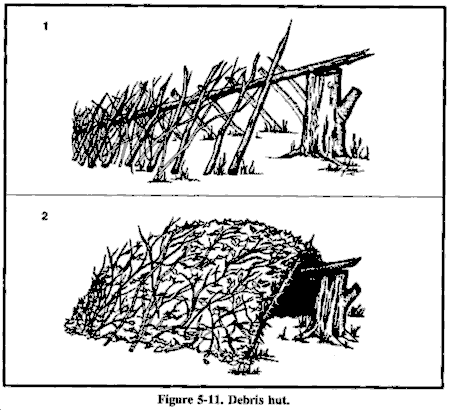Wilderness Survival Shelter
Knowing how to make a wilderness survival shelter can mean the difference between life and death if an apocalyptic event forces you out of your home or you end up stuck in the wild. The type of shelter that you will be able to make will depend on what resources you have with you and what space and materials are available to you. The key to any shelter is stop and assess your location for safety from the elements, predators or land movement such as rockslides or falling branches.
Using What You Find

If you’re away from home and don’t have any shelter making equipment with you or stored in your car, you’ll need to be able to make a wilderness shelter out of your natural surroundings. Popular choices for a natural shelter include:
- Caves — If you live anywhere in the northern half of the U.S., you’ll find all sorts of useful nooks and crannies even in the woods where the glaciers from the last Ice Age will have gouged out the land and left big rocks behind. Caves make for excellent shelters as they will protect against the wind and rain while giving you one single point of entry to defend.
- Branches — Fallen branches often are the right length to make a temporary lean-to or tent and they can support an additional canopy of leaves or smaller live branches. You should use fallen branches, as the wood will be dead and much easier to snap and form into the required shapes and positions for your wilderness survival shelter.
- Quincys — A Quincy is a quick and easy way to make a warm shelter if you are caught out in the middle of winter. You simply pile a massive mound of snow together and then burrow a tunnel into the middle. The insulating properties of snow keeps you warm and the size of the mound ensures that it will maintain its structural integrity even as your body heat starts to melt the compact snow.
Basic Shelter Equipment
Building a wilderness shelter as listed above is a time and energy intensive way of making a shelter. Even a cave requires you to go looking and investigating the end of each cave for suitability. For this reason, it is a good idea to have a basic set of shelter equipment that will help you to construct a safe place in a short amount of time:
- Rope or para cord — A decent length will allow you to strap branches together, tie sheets or plastic into position or to act as the central beam in a tent. You should aim to have a length of para cord measuring approximately 20 feet in length to give yourself plenty of spare rope.
- Plastic sheeting — At a very minimum level, you can sit under plastic sheeting during extreme weather and use it to cover any survival equipment that you have with you. You can use it in conjunction with the rope to create lean-tos or as cover to make the tent. A sheet that measures over 12 square feet will provide you with a large amount of cover and some spare to use as storage.
- Knife — This should be part of any wilderness kit, but it especially helps when you need to cut wood to certain lengths or to divide your rope into smaller sections.
Once you have these basics, you should be able to make typical shelters like lean-tos, tents, canopies or tepees. It is worth making each type in your surrounding area so you know what the landscape will allow you to make. You can then leave equipment to make a survival shelter in your car and at home.
Return from Wilderness Survival Shelter to Survival Retreat





New! Comments
Have your say about what you just read! Leave me a comment in the box below.